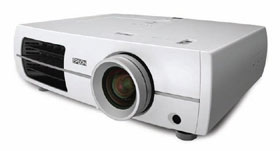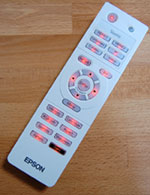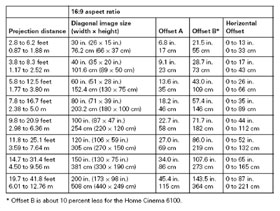 |
; |
Verdict: HIGHLY RECOMMENDED
Epson 6500UB Highlights:
MSRP: $2,999.99 (USD) With the release of the Epson 6500UB (and the prior 6100), Epson has now completely revamped and replaced their prior Epson 1080UB and Epson 1080 home theater projectors. While those two models dropped the performance gauntlet in 1080p projector class, and can now ride off admirably into the sunset like conquering heroes, with the 6100 and now the 6500UB, Epson’s tradition of superior home theater displays has achieved a whole new level of performance excellence that can only be termed a smashing a success. FIRST IMPRESSIONS- Epson 6500UB Home Theater LCD ProjectorStyle & Appearance In terms of styling and design, the only thing that the Epson 6500UB and the Epson 1080UB share is the off-white, pearlescent color chassis. Gone are the (appealing) rounded, contour edges, replaced instead with straighter edges and a larger overall size. Speaking of which, the dimensions of the 6500UB are (W x D x H): 17.7 x 15.5 x 5.4 inches, and it tips the scales at 16.5 pounds. While I tend to prefer the look of the Epson 1080UB, the 6500UB still has a good deal of visual appeal that will work well with any room in the house. The top of the projector eliminates the Menu, Escape, Enter, and directional keys (they’re now on the left side of the projector) and features only the Power and Source button. Also atop the projector you’ll find the familiar manual turn dials that offer vertical (96.3% max., up and down) and horizontal (47.1% max., left and right) lens shift. The lens itself offers the standard zoom and focus functionality, and like all Epson home theater projectors, the 6500 offers a great manual zoom ratio of 2.1:1, making setup a breeze in virtually any setting. Another added bit of user convenience on the part of Epson is placing the lens replacement section on the top of the projector as opposed to the bottom. So whether your projector is mounted or sitting on a desk, you’ll always have quick and hassle-free access when needing to replace the bulb which offers up to 4000 hours of lamp life. The rear of the projector plays host to all of the inputs, while the front of the unit features dual height adjustable legs. Getting Connected Nicely laid out and clearly labeled, the 6500UB home theater projector offers up all the input connectivity – HD and otherwise – that you’ll need. The rear panel inputs are a carbon copy for those available on the 6100 and include: HDMI 1.3a (2), Component (1), S-Video (1), Composite (1), VGA (1), and RS-323C (1). Remote Control
PERFORMANCE - Epson 6500UB LCD ProjectorSet-Up Playing a big part in what makes Epson projectors as good as they are is the ease with which they can be set up. As mentioned earlier, the 6500UB has a zoom lens with a 2.1:1 ratio, along with horizontal and vertical lens shift that offer maximum shift ranges of 47.1% and 96.3% respectively. All of these attributes essentially allow you to set up the projector in any type of room, without any issues throwing an image that perfectly fills your screen. In my particular case, I was able to throw a 106-inch image from about 12 feet away in seconds. As per hardware specs, the Epson 6500UB can throw a (16:9 aspect ratio) one- hundred inch image from as close as 9.8 feet, and as far as 20.9 feet. For those looking to go super big and bold, you can throw a 200-inch image from as close as 19.7 feet, and as far as 41.8 feet. Please refer to the chart below for more detailed information. Now that you’ve got your image projected just right, the next order or business is familiarizing yourself with the user menus for the 6500UB so that you can get the most out of this projector. Epson’s motto has always been to offer a comprehensive and exhaustive mix of options that still somehow manage to be straightforward and easy to use, whether you’re a seasoned, tech-savvy expert, or a green newbie who just purchased their very first projector. While there’s simply too much menu material to cover in a projector review, I’ll touch on the vast amount of options that can be found in the first menu: Image. Here you can adjust for all the usual items such as Brightness, Contrast, Sharpness, Color Saturation, Tint, and Sharpness. Additionally, you can adjust for Absolute Color Temperature, Auto Iris, and pick from seven different options in Color Mode which are tailored to what you’re watching and how bright or dark the room is that you’re watching in. If you never venture beyond this point when it comes to tweaking your image, you’ll have more than enough here to play with and find the image that works best for you. For those who are more technically inclined and like to experiment with all the subtle nuances of their image, the 6500UB will serve you well by accessing the Advanced section of the Image menu. It’s here you can adjust your Gamma from five settings ranging from 2.0 to 2.4. There’s also an RGB option that lets you adjust Gain and Offset for your red, green, and blue. And taking image customization to a whole other level, you’ll also find a section for RGBCMY which allows you to individually adjust the Hue, Saturation, and Brightness for red, green, blue, cyan, magenta, and yellow. Along with Image, you’ll also find six more menus: Signal, Settings, Memory, Info, and Reset. A major point worth noting: one of the primary marketing angles with the 6500UB is 120 Hz FineFrame technology which can be accessed from the Signal menu in the option for Frame Interpolation which offers three levels: Low, Normal, and High. In theory, this allows for smoother video playback by virtue of analyzing and comparing current and previous frames, and then creating a frame between them which reduces image fuzziness. While this all sounds glorious and altogether hunky dory, as I’ll touch on further down below in the Out-Of-Box picture section, you’re best advised to AVOID using this feature at all costs and making sure it’s always turned OFF, never to be turned on or accessed again. Out-Of-Box Picture Still smiling from the A-plus experience I had with the Epson 6100, I could hardly wait to sink my teeth into the 6500UB. For testing purposes, I was connected via HDMI (1080p), using the Pioneer BDP-51FD, and the Blu-ray discs were BBC’s Planet Earth, The Fifth Element, and one of the numerous films that Ben Affleck wants you to permanently forget from his filmography, Pearl Harbor. As always, the projector was initially tested using out-of-box, factory default settings. The first thing you’ll notice right off the hop is just what a bright, vivid, and punchy image the 6500UB can display. Blacks were noticeably black, more so than the 6100, so it’s good to see that the UltraBlack technology specific to the 6500UB and 1080UB is put to good use and isn’t simply marketing hyperbole. Contrast detail was also good, as was color gradation which was silky smooth and positively band-free, doing a tremendous job seamlessly blending colors together. Most projectors out of the box have images that are dialed up a bit, and while the 6500UB wasn’t as obvious as most, there was some adjusting that needed to be done. I made the following adjustments:
The net results here were well worth the minimal effort required to do so. While images were still bright, vivid, and punchy, they offered a more realistic degree of color saturation and sharpness that was smooth and natural. Contrast detail was well above average, and using the movie’s black bars as barometers for ideal black levels, the blacks on-screen were virtually indistinguishable from the bars. While it’s become almost reasonable and common place to accept dark gray images as black, when you get the chance to watch images that feature proper black levels that are deep and ultra-dark, you develop a whole new appreciation for an image that simply astounds. It’s worth mentioning that while dialing back brightness and amping up contrast are quick and easy ways to get better black levels, when you’re using inferior display products, this also adversely affects the overall picture quality, making the images appear dark, and subtracting all the fine details that contribute to making an image as good as it can be. With the 6500UB, I’m happy to report that this wasn’t the case at all. I mentioned in the section just up above about how the 6500UB utilizes 120 Hz FineFrame technology which is said to create smoother, clearer images. If by smooth and clear they actually meant choppy, artificial, and outright horrendous, then the marketing brochures would’ve been right on the money. At first I thought maybe it was the films I was watching, which themselves incorporate a lot of CGI and visual effects (The Fifth Element and Pearl Harbor), but when I used the Frame Interpolation on Planet Earth, the picture quality – or lack thereof – was no different. All the subjects appeared obnoxiously bright and stood out from the rest of the frame as though they were performing in front of a green screen that hadn’t been completely adjusted in post-production for a proper theatrical release. Motion made things even worse, as things went from looking sped up to lagging behind and then speeding up to catch up again, creating a choppiness and jaggedness of motion I haven’t seen in ages. Can you say: “Where’s the Advil?” While this Frame Interpolation feature had three levels of adjustment (Low, Normal, High), each one rendered the picture progressively worse. Thankfully, there’s also the Off option which is certainly a case of addition by subtraction. No harm, no foul, and like it never even happened at all. On the plus side, the 6500UB supports 24p playback and if you’re watching your films in this mode, the Frame Interpolation feature is inactive. Let’s now move on to the calibration of the 6500UB. Calibration As was done on the 6100, two calibrations were performed on the 6500UB – one for dark, home theater lit rooms, and one for brighter, daytime scenarios. And as always, the target color temperature is 6500K. The first calibration was the dark room, home theater calibration, and for all intents and purposes, this is the one which is the ideal viewing scenario, especially if you plan on doing a whole lot of movie watching. The initial color temperature clocked in at 5854K before a red/blue push in the 70 IRE range was dialed back, leaving us with a very ideal color temperature of 6420K. In the 15 IRE bracket, there was again a red/blue push, though the red was the greater of the two. Once the RGB offsets were adjusted accordingly, color temperature cruised into a most welcome color temperature of 6450K. The bright room calibration proved to be far trickier, due in no small part to the particulars of the room which featured seven pot lights, giving the room an extreme red bias and blue deficiency which did much to throw color temperature figures all over the map. This scenario was somewhat offset by adjusting the projector’s color temperature from 6500K to 7000K. In the 70 IRE range, this issue was less apparent as the initial projector color temperature was 6056K before white balance adjustments got us to where we wanted to be with a color temperature of 6402K. Any sub-50 IRE range was far more vulnerable to the room, with an initial projector color temperature hovering barely above 3400K. Maxing out red and blue gains got us to a color temperature, which, though far from ideal at 5019K, was just a cold hard fact of the room. And as a colleague of mine commented, any worthwhile and effective bright room calibration is – and should be – concerned with the brighter IRE ranges as opposed to the lower ones. Going back and re-watching select scenes from Planet Earth – be it in a darkened room or a bright room – the fruits of my labor were well rewarded: various colors showed a greater degree of separation where all the fine, subtle, and nuanced details were more apparent, thus creating richer and more textured images. Do you need to calibrate the Epson 6500UB? Absolutely not. Out-of-box with just a few tweaks here and there offer gorgeous image quality that’s as good as anything currently out there, and while calibration will squeeze a little more juice out of it, the question then becomes how much juice do you really need to quench your thirst? Ultimately, this is entirely up to you. FINAL THOUGHTS - Epson 6500UB Home Theater LCD ProjectorIf you can ignore and forget that whole 120 Hz FineFrame technology debacle (which shouldn’t be too hard since you can turn it off), the Epson 6500UB will reward you with one of the finest in-class, HD, 1080p home theater experiences you’re likely to come across. Colors pop with sharpness and clarity that astonishes, contrast and black levels are positively stupendous, and set up is quick, easy, and painless. If you thought the 1080UB was the benchmark in top-shelf, grade-A, 1080p image quality, the 6500UB absolutely blows the roof off, taking things to a whole new level of awe-inspiring bliss. And while some may dispute the $1,000-plus price increase between this and the less expensive 6100, trailblazing video processing in the form of UltraBlack technology, along with a 12-bit panel driver, a built-in HQV processor, and a best-in-class 75,000:1 contrast ratio all conspire to make the 6500UB worth every penny. DETAILED SPECIFICATIONS - Epson 6500UB LCD Projector
Highly Recommended
Video Projector Reviews
|
JVC DLA-X30 Review |
|||||||||||||||||||||||||||||||||||||||||||||||||||||||||
|
Home • Projector Brands • Video Projector Reviews • Projector Resources • Contact Us
|



